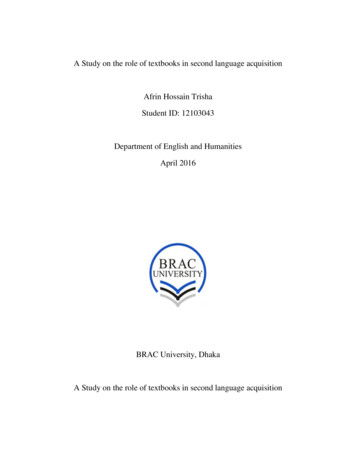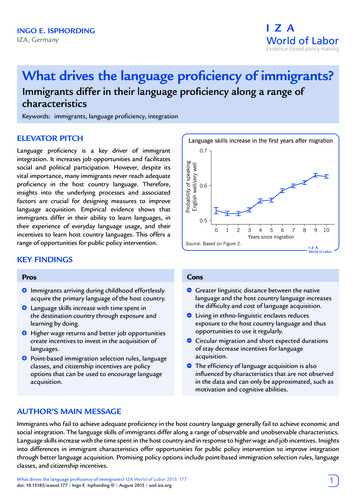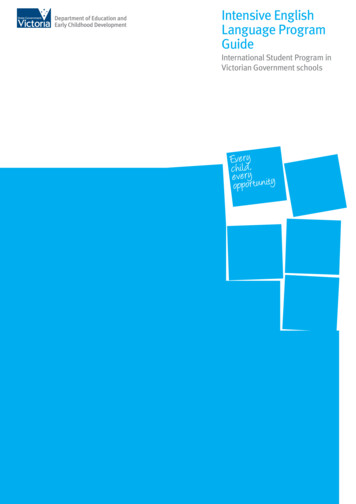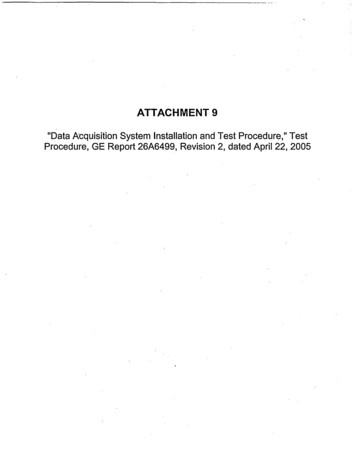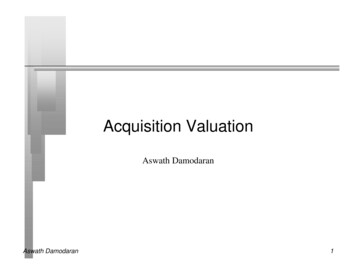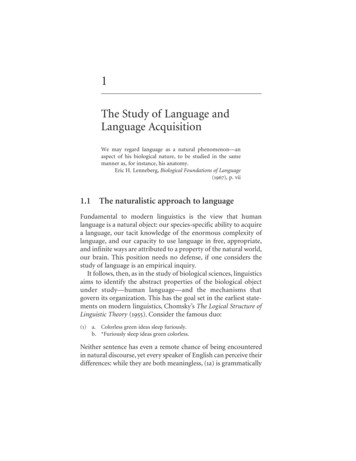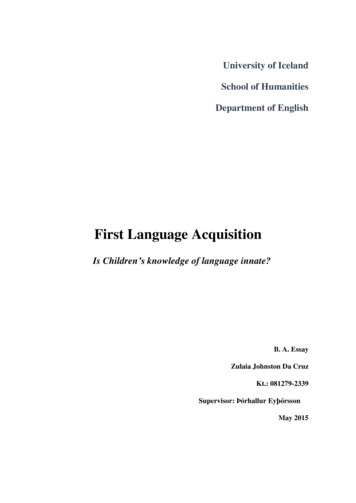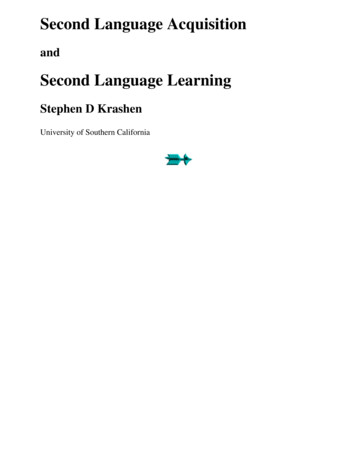
Transcription
Second Language AcquisitionandSecond Language LearningStephen D KrashenUniversity of Southern California
Copyright 1981 Stephen KrashenAll Rights Reserved. This publication may be downloaded and copied withoutcharge for all reasonable, non-commercial educational purposes, provided noalterations in the text are made.First printed edition 1981 by Pergamon Press Inc.Print Edition ISBN 0-08-025338-5First internet edition December 2002i
AcknowledgmentsI would like to thank the following journals and organizations for grantingpermission to reprint material: Newbury House, the Center for Applied Linguistics,Language Learning, TESOL, the SPEAQ Journal, Academic Press.I have had a great deal of help and feedback from many people in writing this book.Among the many scholars and friends I am indebted to are Marina Burt, EarlStevick, Heidi Dulay, Robin Scarcella, Rosario Gingras, Nathalie Bailey, CarolynMadden, Georgette Ioup, Linda Galloway, Herbert Seliger, Noel Houck, JudithRobertson, Steven Sternfeld, Batyia Elbaum, Adrian Palmer, John Oller, JohnLamendella, Evelyn Hatch, John Schumann, Eugene Brière, Diane Larsen-Freeman,Larry Hyman, Tina Bennet, Ann Fathman, Janet Kayfetz, Ann Peters, Kenji Hakuta,Elinor Ochs, Elaine Andersen, Peter Shaw, and Larry Selinker. I also would like toexpress my thanks to those scholars whose work has stimulated my own thinking inthe early stages of the research reported on here: John Upshur, Leonard Newmark,and S. Pit Corder all recognized the reality of language "acquisition" in the adultlong before I did. I would also like the thank Eula P. Krashen and Judy Winn-BellOlsen for their special contributions.ii
ContentsIntroduction11. Individual Variation in the Use of the Monitor122. Attitude and Aptitude in Second Language Acquisition and Learning193. Formal and Informal Linguistic Environments in Language Acquisition andLanguage Learning404. The Domain of the Conscious Grammar: The Morpheme Studies515. The Role of the First Language in Second Language Acquisition646. The Neurological Correlates of Language Acquisition: Current Research707. On Routines and Patterns in Language Acquisition and Performance838. Relating Theory and Practice in Adult Second Language Acquisition1009. The Theoretical and Practical Relevance of Simple Codes in Second LanguageAcquisition119Bibliography138iii
IntroductionThis book is concerned with what has been called the "Monitor Theory" of adultsecond language acquisition. Monitor Theory hypothesizes that adults have twoindependent systems for developing ability in second languages, subconsciouslanguage acquisition and conscious language learning, and that these systems areinterrelated in a definite way: subconscious acquisition appears to be far moreimportant.The introduction is devoted to a brief statement of the theory and its implicationsfor different aspects of second language acquisitions theory and practice. We defineacquisition and learning, and present the Monitor Model for adult second languageperformance. Following this, brief summaries of research results in various areas ofsecond language acquisition serve as both an overview of Monitor Theory researchover the last few years and as introduction to the essays that follow.Acquisition and Learning and the Monitor Model for PerformanceLanguage acquisition is very similar to the process children use in acquiring firstand second languages. It requires meaningful interaction in the target language-natural communication--in which speakers are concerned not with the form of theirutterances but with the messages they are conveying and understanding. Errorcorrection and explicit teaching of rules are not relevant to language acquisition(Brown and Hanlon, 1970; Brown, Cazden, and Bellugi, 1973), but caretakers andnative speakers can modify their utterances addressed to acquirers to help themunderstand, and these modifications are thought to help the acquisition process(Snow and Ferguson, 1977). It has been hypothesized that there is a fairly stableorder of acquisition of structures in language acquisition, that is, one can see clear1
similarities across acquirers as to which structures tend to be acquired early andwhich tend to be acquired late (Brown, 1973; Dulay and Burt, 1975). Acquirersneed not have a conscious awareness of the "rules" they possess, and may selfcorrect only on the basis of a "feel" for grammaticality.Conscious language learning, on the other hand, is thought to be helped a great dealby error correction and the presentation of explicit rules (Krashen and Seliger,1975). Error correction it is maintained, helps the learner come to the correct mentalrepresentation of the linguistic generalization. Whether such feedback has this effectto a significant degree remains an open question (Fanselow, 1977; Long, 1977). Noinvariant order of learning is claimed, although syllabi implicitly claim that learnersproceed from simple to complex, a sequence that may not be identical to theacquisition sequence.The fundamental claim of Monitor Theory is that conscious learning is available tothe performer only as a Monitor. In general, utterances are initiated by the acquiredsystem--our fluency in production is based on what we have "picked up" throughactive communication. Our "formal" knowledge of the second language, ourconscious learning, may be used to alter the output of the acquired system,sometimes before and sometimes after the utterance is produced. We make thesechanges to improve accuracy, and the use of the Monitor often has this effect.Figure 1 illustrates the interaction of acquisition and learning in adult secondlanguage production.Fig.1. Model for adult second language performanceThe acquisition-learning distinction, as I have outlined it, is not new: Lawler andSelinker (1971) propose that for rule internalization one can "postulate two distincttypes of cognitive structures: (1) those mechanisms that guide 'automatic' languageperformance. that is, performance. where speed and spontaneity are crucial andthe learner has no time to consciously apply linguistic mechanisms. and (2) thosemechanisms that guide puzzle- or problem-solving2
performance." (p.35). Corder (1967), citing an unpublished paper by Lambert, alsodiscusses the acquisition-learning distinction and the possibility that acquisition isavailable to the adult second language performer.The Monitor Theory differs somewhat from these points of view, in that it makessome very specific hypotheses about the inter-relation between acquisition andlearning in the adult. In the papers that follow, I argue that this hypothesis shedslight on nearly every issue currently under discussion in second language theory andpractice.Conditions of Monitor UseThere are several important constraints on the use of the Monitor. The firstcondition is that in order to successfully monitor, the performer must have time. Innormal conversation, both is speaking and in listening, performers do not generallyhave time to think about and apply conscious grammatical rules, and, as we shallsee later, we see little or no effect on the Monitor in these situations. This condition,however, is necessary but not sufficient. Heidi Dulay and Marina Burt have pointedout to me that a performer may have time but may still not monitor, as he or shemay be completely involved with the message. There is, thus, a second condition:the performer must be "focused on form", or correctness. As we shall see later, thesecond condition predicts some recent data nicely.An important third condition for successful Monitor use is that the performer needsto know the rule, he or she needs to have a correct mental representation of the ruleto apply it correctly. This may be a very formidable requirement. Syntacticiansfreely admit that they have only analyzed "fragments" of natural languages, appliedlinguists concede that they have mastered only part of the theoretical literature ingrammar, language teachers usually do not have time to fully study the descriptivework of all applied linguists, and even the best language students do not usuallymaster all the rules presented to them.It is therefore very difficult to apply conscious learning to performance successfully.Situations in which all three conditions are satisfied are rare (the most obviousbeing a grammar test!).3
Note that the model presented here allows us to self-correct using acquiredknowledge of language, or our "feel" for grammaticality. That is what nativespeakers generally do in the case of speech errors. The point is not that we can onlymonitor using conscious rules. This is not the case. The point is that consciouslearning is only available as a Monitor.In the last few years, the acquisition-learning distinction has been shown to beuseful in explaining a variety of phenomena in the field of second languageacquisition. While many of these phenomena may have alternative explanations, theclaim is that the Monitor Theory provides for all of them in a general, non ad hocway that satisfies the intuitions as well as the data. The papers in this volume reviewthis research, and include discussion of how the second language classroom may beutilized for both acquisition and learning.Individual VariationChapter 1, based on a paper written in 1976 and published in Ritchie (1978),describes how the learning-acquisition distinction captures one sort of individualvariation in second language performance. Based on case histories, this sectionproposes that there are basically three types of performer:Monitor "overusers" are performers who feel they must "know the rule" foreverything and do not entirely trust their feel for grammaticality in the secondlanguage. One case, "S", described by Stafford and Covitt (1978), remarked: "I feelbad. when I put words together and I don't know nothing about the grammar." InStevicks terms (Stevick, 1976, p. 78), overusers may suffer from "lathophobicaphasia", an "unwillingness to speak for fear of making a mistake".At the other extreme is the underuser, who appears to be entirely dependent on whathe can "pick up" of the second language. Underusers seem to be immune to errorcorrection, and do not perform well on "grammar" test. They may acquire a greatdeal of the target language, however, and often use quite complex constructions.The optimal user is the performer who uses learning as a real supplement toacquisition, monitoring when it is appropriate and4
when it does not get in the way of communication (e.g. prepared speech andwriting). Very good optimal users may, in fact, achieve the illusion of nativespeaker competence in written performance. They "keep grammar in its place",using it to fill gaps in acquired competence when such monitoring does not get inthe way of communication.Attitude and AptitudeChapter 2 illustrates how the acquisition-learning hypothesis provides aparsimonious explanation for what had appeared (to me) to be a mysterious finding:both language aptitude, as measured by standard language aptitude tests, andlanguage attitude (affective variable) are related to adult second languageachievement, but are not related to each other.This section explores two hypotheses that attempt to account for this problem. Thefirst is that aptitude may be directly related to conscious learning (especially certaincomponents as detailed in Chapter 2). As we shall see in Chapter 2, scores onaptitude tests show a clear relationship to performance on "monitored" test situationand when conscious learning has been stressed in the classroom.Second language attitude refers to acquirers' orientations toward speakers of thetarget language, as well as personality factors. The second hypothesis is that suchfactors relate directly to acquisition and only indirectly to conscious learning.Briefly, the "right" attitudinal factors produce two effects: they encourage usefulinput for language acquisition and they allow the acquirer to be "open" to this inputso it can be utilized for acquisition.The pedagogical implications of these hypotheses will not surprise manyexperienced teachers: if the direct relationship between acquisition and attitudinalfactors does exist, and if our major goal in language teaching is the development ofcommunicative abilities, we must conclude that attitudinal factors and motivationalfactors are more important the aptitude. This is because conscious learning makesonly a small contribution to communicative ability.Chapter 2 also contains a discussion of the nature of child-adult differences,claiming that the Monitor, the conscious grammar, may5
owe its source to Piaget's Formal Operations stage. Affective changes that occuraround puberty, some related to Formal Operations, affect language acquisition. Thechapter concludes with a re-definition of the "good language learner", now definedas someone who is first and foremost an acquirer, and who may also be an "optimalMonitor user".Chapter 2 originally appeared in Diller (1980).Formal and Informal Linguistic EnvironmentsChapter 3 is a revised version of a paper that appeared in the TESOL Quarterly in1976 (see Krashen, 1976a). It shows how the acquisition-learning distinction helpsto solve a puzzle in the second language acquisition research literature: severalstudies apparently show that formal learning environments are best for attainingsecond language proficiency, while other studies appear to show that informalenvironments are superior. In this section, it is argued that informal environments,when they promote real language use (communication) are conducive to acquisition,while the formal environment has the potential for encouraging both acquisition andlearning.This chapter, then, begins the discussion of the potential of the second languageclassroom for language acquisition, a discussion that is continued in later sections(Chapters 8 and 9).The Domain of the Conscious Grammar: The Morpheme StudiesChapter 4 reviews research pertaining to acquisition or difficulty order of certainstructures, that is, which structures adult second language acquirers tend to acquireearly and which they tend to acquire late.The value of these studies is considerable. They provide more information thanmerely showing us the actual order of acquisition. They also show us whenperformers are using conscious grammar and when they are not. We havehypothesized that when conditions for "Monitor-free" performance are met, whenperformers are focused on communication and not form, adult errors in English as asecond language (for grammatical morphemes in obligatory occasions1) are quitesimilar to errors made by children acquiring English as a second6
language (some similarities to first language acquisition have been noted as well).When second language speakers "monitor", when they focus on form, this "naturalorder" is disturbed. The appearance of child-like errors in Monitor-free conditions ishypothesized to be a manifestation of the acquired system operating in isolation, orwith little influence of the Monitor.Current research in the "morpheme studies" supports the hypothesis that secondlanguage performers utilize the conscious grammar extensively only when they haveto do extreme "discrete-point" grammar tests, test that test knowledge of rules andvocabulary in isolation.Also included in Chapter 4 is a response to some criticisms of the morpheme studies.Material in Chapter 4 was previously published in Gingras (Krashen, 1978b) and in apaper appearing in On TESOL '77 (Krashen, 1977a).The Role of the First LanguageChapter 5 deals with so-called first language "interference". It attempts to providesome empirical data for a position first held by Newmark (1966): "interference" is notthe first language "getting in the way" of second language skills. Rather, it is theresult of the performer "falling back" on old knowledge when he or she has not yetFig. 2. First language influence in second language performance.acquired enough of the second language. In terms of the Monitor performance model,interference is the result of the use of the first language as an utterance initiator: firstlanguage competence may replace acquired second language competence in theperformance model, as in Fig. 2.From the data we have so far, this hypothesis correctly predicts that those aspects ofsyntax that tend to be acquired are also those that show first-language-influencederrors in second language performance.7
First language influence may thus be an indicator of low acquisition, or the result ofthe performer attempting to produce before having acquired enough of the targetlanguage. It is, not surprisingly, found most often in foreign language, as opposed tosecond language situations, where opportunities for real communication are fewer,and is only rarely seen in "natural" child second language acquisition. Children areusually allowed to go through a "silent period", during which they build up acquiredcompetence through active listening. Several scholars have suggested that providingsuch a silent period for all performers in second language acquisition would bebeneficial (see for example, Postovsky, 1977)Note that it is possible for performers to use the first language and the Monitor toperform without any acquired competence in the second language. This bizarremode is severely limited, yet its use may give the adult a temporary head-start overchildren, who presumably rely on acquisition alone for the most part.This chapter is a slightly expanded version of a paper that originally appeared in OnTESOL '77 (Krashen, 1977a).Neurological CorrelatesChapter 6 was originally published in the SPEAQ Journal, coauthored with LindaGalloway (Krashen and Galloway, 1978). It discusses current research in two areasof neurolinguistics and the relationship of this research to the acquisition-learninghypothesis. The first part of this chapter deals with the development of cerebraldominance, and explores research bearing on Lenneberg's hypothesis that childadult differences in second language acquisition are due to the completion of thedevelopment of cerebral dominance, hypothesized by Lenneberg to occur at aroundpuberty. More recent reports place the completion of the development of cerebraldominance much earlier (some claiming age 5, others claiming that laterality ispresent at birth). The implications of this research are that the "critical period" andcerebral dominance may not be related at all. Other explanations of child-adultdifferences are discussed, namely the hypothesis presented in Chapter 2, thatFormal Operations causes an increase in our ability to learn but damages our abilityto acquire.8
In the second part of this chapter, the role of the right hemisphere in languageacquisition is discussed. Psychological and neurological evidence is presented insupport of the hypothesis that there is an early stage in second language acquisition(not learning) that involves the right side of the brain. Since it may be the case thatearly first language acquisition also involves some right hemisphere participation,confirmation of such a hypothesis would strengthen the parallel between first andsecond language acquisition.Routines and PatternsChapter 7 originally appeared in Language Learning and was coauthored withRobin Scarcella.Routines and patterns are "memorized language". Routines are whole sentences orphrases, such as How are you?, and patterns are sentence frames with open slots,such as That's a ------. A performer can use routines and patterns without learned oracquired knowledge of its internal parts. This chapter presents evidence to supportthe hypothesis that routines and patterns are fundamentally different from bothacquired and learned language, and they do not "turn into" acquired or learnedlanguage directly. This evidence is drawn from neurolinguistic research, and studiesin child first, child second, and adult language acquisition. Routines and patternsmay be quite helpful, however, in establishing and maintaining social relations, andmanaging conversations, as Fillmore's work points out.Theory to PracticeChapter 8 deals directly with application to the second language classroom. Itfocuses, first of all, on the important question of how we acquire, concluding thatcomprehensible input is the crucial and necessary ingredient. This hypothesis, the"Input Hypothesis", is discussed in more detail in Chapter 9. I then discuss whatsorts of activities provide comprehensible input, input language in which the focusis on the message and not the form.This chapter is optimistic with respect to the role and value of the classroom inencouraging second language acquisition, suggesting that9
the classroom should be viewed as a place where the student can get the input he orshe needs for acquisition. The classroom may be superior to the outside world forbeginning and low intermediate students, in that the real world is often quiteunwilling to provide such students with comprehensible input, as Wagner-Goughand Hatch have pointed out.This section also discusses the possible role of conscious learning, pointing out that"easy" rules can be taught for optimal Monitor use, but that "hard" rules may onlyserve a "language appreciation" function for most students.An earlier version of this chapter was published in the SPEAQ Journal (Krashen,1978d) and in Felix (1980).The Relevance of Simple CodesThe final chapter, Chapter 9, is the most recently written, and appeared in Scarcellaand Krashen (1980). It focuses on the question of simplified input, both inside theclassroom (i.e. teacher-talk) and outside the classroom (i.e. foreigner talk), askingwhether such simplified input is of use to second language acquisition. Theconclusion is that such input is not only highly useful, but it is possibly essential.Simple codes may provide for the second language acquirer what "caretakerspeech" provides for the first language acquirer, comprehensible input with a low"affective filter".Simple codes, input that the acquirer understands, are not deliberatelygrammatically sequenced or controlled. Rather, the speaker is only concerned withwhether the listener understands the message. It is quite possible, it is argued, thatthe natural "net" of grammatical structures that such simple codes provide is anexcellent natural syllabus, presenting a sufficient quantity of those structures thatacquirer is "ready" to acquire, and allowing for built-in review.The implications are as follows: the best language lessons may be those in whichreal communication takes place, in which an acquirer understands what the speakeris trying to say. Similarly, a reading passage is appropriate for a student if he or sheunderstands the message. Finally, the teacher-talk that surrounds the exercises maybe10
far more valuable then the exercise itself. We teach language best when we use itfor what it was designed for: communication.Note1Correct use in obligatory occasions means simply that the acquirer supplied the morpheme where itwas required. For example, the underlined portion of this sentence is an obligatory occasion for theplural morpheme in English:I have three pencil .Analysis of grammatical morphemes in obligatory occasions was begun by Brown (1973). Asindicated in Chapter 4, analysis in obligatory occasions does not give a complete picture of languageacquisition. It does, however, provide valuable information on order of acquisition of grammaticalitems.11
1. Individual Variation in the Use ofthe MonitorThe acquisition-learning distinction helps interpret findings in all areas in secondlanguage acquisition research and practice. One important area, the first we shalldeal with, is the area of individual variation.As discussed in the Introduction, one might suppose that individual secondlanguage performers would vary with respect to the extent to which they utilize theMonitor in second language production. At one extreme end of the continuum,some performers might utilize conscious knowledge of the target languagewhenever possible. Extreme Monitor users might, in fact, be so concerned withediting their output to make it conform to their conscious rules that fluency wouldbe seriously hampered. At the other end of the continuum, we may find those whoalmost never monitor their output.These sorts of individuals do exist, and their case histories are revealing, both as tothe theoretical question regarding the operation of the Monitor Model, and withrespect to the practical question of that role instruction should play in helpingsecond language performers improve.General Characteristics of Monitor UsersBefore describing the extreme cases, we shall first turn to some typical instances ofMonitor utilization in adult second language performance. Several informal casestudies will be presented to illustrate some general characteristics of Monitor users,namely:1.Successful Monitor users edit their second language output when itdoes not interfere with communication.2.This editing results in variable performance, that is, we see differenttypes and amounts of errors under different conditions.12
Monitoring generally improves accuracy levels, and as we have notedabove, under edited conditions, where attention is on form, we nolonger see the child's "natural" difficulty order.3.Monitor users show an overt concern with "correct" language, andregard their unmonitored speech and writing as "careless".Case Studies of Monitor UsersAn interesting case study, illustrating some of the points mentioned above, is P, a fairlytypical successful Monitor user studied by Krashen and Pon (1975). P was a nativespeaker of Chinese in her 40s, who had begun to learn English sometime in her 20swhen she came to the United States. About 5 years before she was studied by Krashenand Pon, she had enrolled in college, and had graduated with an "A" average.Krashen and Pon studied P's casual, everyday language production. Observers, nativespeakers of English (usually P's son), simply recorded her errors from utterances sheproduced in normal family living or in friendly conversational situations. Immediatelyafter an utterance containing an error was recorded, it was presented to the subject. Thedata were gathered over a 3-week period and about 80 errors were tabulated.Upon considering P's self-correction behaviour, the investigators came to what was thenan unexpected conclusion:We were quite surprised to note. that our subject was able to correct nearly everyerror in the corpus (about 95%) when the errors were presented to her after theircommission. In addition, in nearly every case she was able to describe thegrammatical principle involved and violated. Another interesting finding was that forthe most part the rules involved were simple, "first level" rules (e.g. omission of thethird person singular ending, incorrect irregular past tense form, failure to make theverb agree with the subject in number (is/are), use of "much" with countable nouns,etc.) (p.126).The fact that the vast majority of P's errors were self-correctable suggested that "she hada conscious knowledge of the rules" but did not choose to apply this knowledge. Furtherevidence that this is the case "is our observation that the subject is able to write avirtually error-free English. In writing, and in careful speech, she utilizes herconscious linguistic knowledge of English, while in casual speech she13
may be too rushed or preoccupied with the message to adjust her output [p. 126]."P thus illustrates the general characteristics of the successful Monitor user notedabove. She is able to communicate well in both Monitor free and edited situations,applying the Monitor when it is appropriate to focus on form. Her performance isvariable, in that she makes some errors in unmonitored speech, while her writtenoutput is quite close to the native speaker's norm. In a sense, she is able to achievethe illusion of the native speaker's syntactic level of performance by efficient,accurate monitoring.Cohen and Robbins (1976) describe two more cases like this in their in-depth studyof learner characteristics. Ue-lin, like P, can self-correct successfully, and describesher errors as "careless". She reports that she likes to be corrected and has thepractice of going over teacher's corrections on her written work. Her backgroundincludes formal training in English.Eva, also described by Cohen and Robbins, is also a Monitor user. Eva made thefollowing statement, which appears to indicate a conscious awareness of Monitoruse: "Sometimes I would write something the way I speak. We say a word more orless in a careless way. But if I take my time, sometimes go over it, that would bemuch easier. Whenever I go over something or take my time, then the rules cometo my mind [p.58]." This statement is easily translated into the vocabulary of theMonitor Model. "Sometimes I would write something the way I speak" reflects theuse of the acquired system in language production when monitoring is not involved.Eva's comments about the "carelessness" of her spoken language, which are similarto Ue-lin's statement, simply reflect the fact that ordinary casual speech is usuallyunmonitored. "The rules come to [her] mind" when she focuses on the form of herutterance ("whenever I go over something"), rather than just on its function ascommunication.Until the creative construction process has completed its mission in the adult secondlanguage performer, the use of monitoring in edited language can certainly be anaid. The world often demands accurate language, even from second language users,in just those domains where Monitor use is most possible--in the written language-and a clear idea of linguistic rules can be a real asset for the performer. An14
overconcern with correctness, however, can be a problem. The overuser may be soconcerned with form that he or she is unable to speak with any fluency at all.The OveruserStafford and Covitt (
2. Attitude and Aptitude in Second Language Acquisition and Learning 19 3. Formal and Informal Linguistic Environments in Language Acquisition and Language Learning 40 4. The Domain of the Conscious Grammar: The Morpheme Studies 51 5. The Role of the First Language
